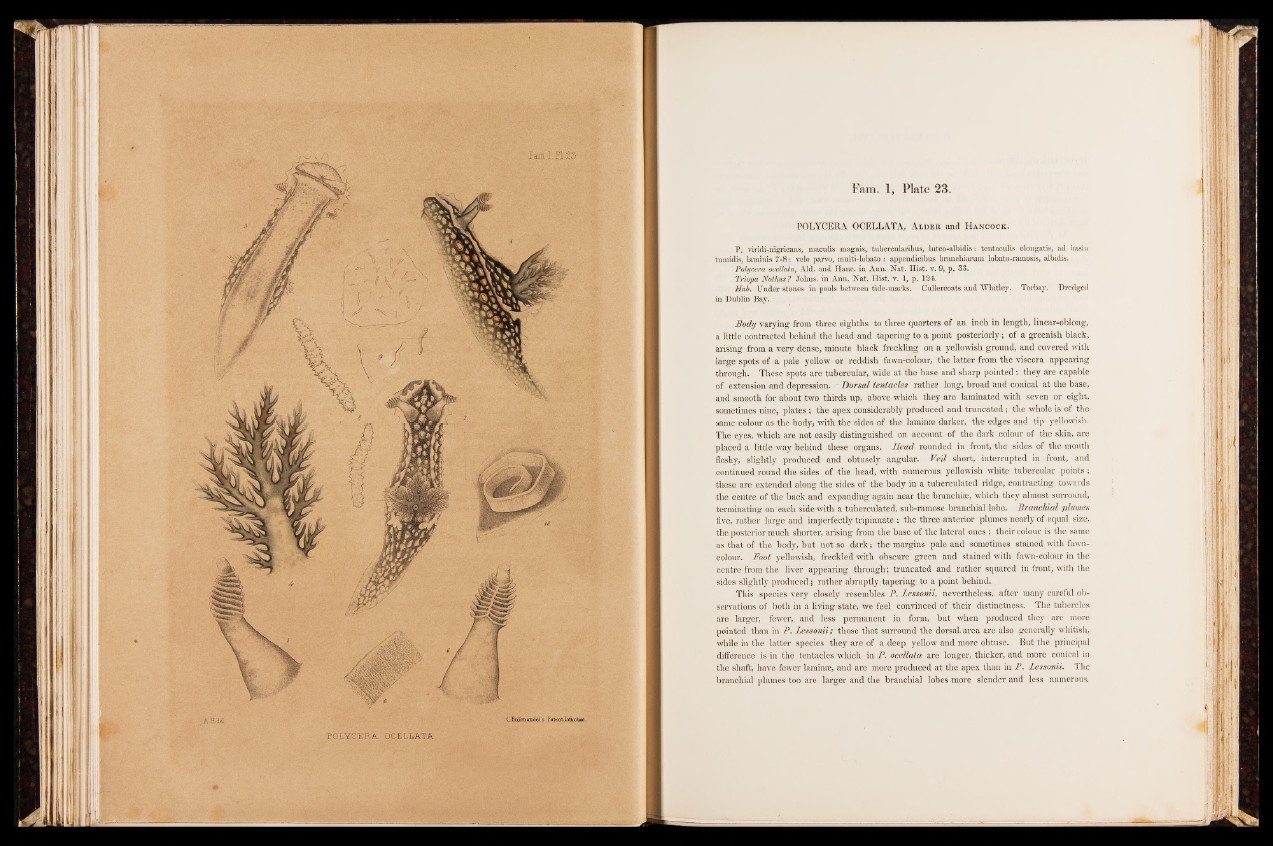
Farn. 1, Plate 23.
POLYCERA OCELLATA, Alder and Hancock.
P. viridi-nigricans, maculis magnis, tubercularibus, luteo-albidis: tentaculis elongatis, ad basin
tumidis, laminis 7-8: velo parvo, multi-lobato : appendicibns brancbiarum lobato-ramosis, albidis.
Polycera ocellata, Aid. and Hanc. in Ann. Nat. Hist. v. 9, p. 33.
Triopa Nothus ? Johns, in Ann. Nat. Hist. v. 1, p. 124.
Hal). Under stones in pools between tide-marks. Cullercoats and "Whitley. Torbay. Dredged
in Dublin Bay.
Body varying from three eighths to three quarters of an inch in length, linear-oblong,
a little contracted behind the head and tapering to a point posteriorly ; of a greenish black,
arising from a very dense, minute black freckling on a yellowish ground, and covered with
large spots of a pale yellow or reddish fawn-colour, the latter from the viscera appearing
through. These spots are tubercular, wide at the base and sharp pointed; they are capable
of extension and depression. Dorsal tentacles rather long, broad and conical at the base,
and smooth for about two thirds up, above which they are laminated with seven or eight,
sometimes nine, plates ; the apex considerably produced and truncated; the whole is of the
same colour as the body, with the sides of the laminse darker, the edges and tip yellowish.
The eyes, which are not easily distinguished on account of the dark colour of the skin, are
placed a little way behind these organs. Head rounded in front, the sides of the mouth
fleshy, slightly produced and obtusely angular. Veil short, interrupted in front, and
continued round the sides of the head, with numerous yellowish white tubercular points ;
these are extended along the sides of the body in a tuberculated ridge, contracting towards
the centre of the back and expanding again near the branchiae, which they almost surround,
terminating on each side with a tuberculated, sub-ramose branchial lobe. Branchial plumes
five, rather large and imperfectly tripinnate ; the three anterior plumes nearly of equal size,
the posterior much shorter, arising from the base of the lateral ones ; their colour is the same
as that of the body, but not so dark; the margins pale and sometimes stained with fawn-
colour. Foot yellowish, freckled with obscure green and stained with fawn-colour in the
centre from the liver appearing through; truncated and rather squared in front, with the
sides slightly produced; rather abruptly tapering to a point behind.
This species very closely resembles P. Lessonii, nevertheless, after many careful observations
of both in a living state, we feel convinced of their distinctness. The tubercles
are larger, fewer, and less permanent in form, but when produced they are more
pointed than in P. Lessonii; those that surround the dorsal, area are also generally whitish,
while in the latter species they are of a deep yellow and more obtuse. But the principal
difference is in the tentacles which in P. ocellata are longer, thicker, and more conical in
the shaft, have fewer laminse, and are more produced at the apex than in P. Lessonii. The
branchial plumes too are larger and the branchial lobes more slender and less numerous.